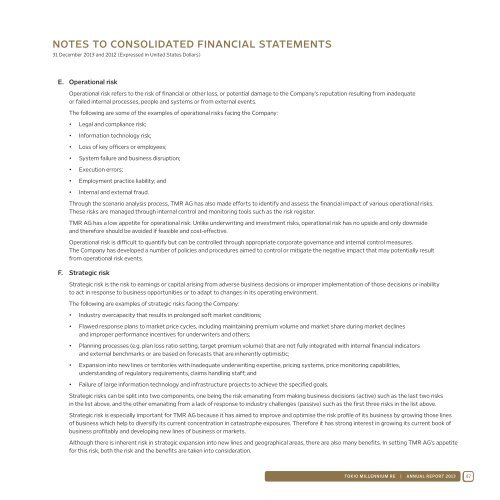ANNUAL REPORT 2013
You also want an ePaper? Increase the reach of your titles
YUMPU automatically turns print PDFs into web optimized ePapers that Google loves.
NOTES TO CONSOLIDATED FINANCIAL STATEMENTS<br />
31 December <strong>2013</strong> and 2012 (Expressed in United States Dollars)<br />
E. Operational risk<br />
Operational risk refers to the risk of financial or other loss, or potential damage to the Company’s reputation resulting from inadequate<br />
or failed internal processes, people and systems or from external events.<br />
The following are some of the examples of operational risks facing the Company:<br />
• Legal and compliance risk;<br />
• Information technology risk;<br />
• Loss of key officers or employees;<br />
• System failure and business disruption;<br />
• Execution errors;<br />
• Employment practice liability; and<br />
• Internal and external fraud.<br />
Through the scenario analysis process, TMR AG has also made efforts to identify and assess the financial impact of various operational risks.<br />
These risks are managed through internal control and monitoring tools such as the risk register.<br />
TMR AG has a low appetite for operational risk. Unlike underwriting and investment risks, operational risk has no upside and only downside<br />
and therefore should be avoided if feasible and cost-effective.<br />
Operational risk is difficult to quantify but can be controlled through appropriate corporate governance and internal control measures.<br />
The Company has developed a number of policies and procedures aimed to control or mitigate the negative impact that may potentially result<br />
from operational risk events.<br />
F. Strategic risk<br />
Strategic risk is the risk to earnings or capital arising from adverse business decisions or improper implementation of those decisions or inability<br />
to act in response to business opportunities or to adapt to changes in its operating environment.<br />
The following are examples of strategic risks facing the Company:<br />
• Industry overcapacity that results in prolonged soft market conditions;<br />
• Flawed response plans to market price cycles, including maintaining premium volume and market share during market declines<br />
and improper performance incentives for underwriters and others;<br />
• Planning processes (e.g. plan loss ratio setting, target premium volume) that are not fully integrated with internal financial indicators<br />
and external benchmarks or are based on forecasts that are inherently optimistic;<br />
• Expansion into new lines or territories with inadequate underwriting expertise, pricing systems, price monitoring capabilities,<br />
understanding of regulatory requirements, claims handling staff; and<br />
• Failure of large information technology and infrastructure projects to achieve the specified goals.<br />
Strategic risks can be split into two components, one being the risk emanating from making business decisions (active) such as the last two risks<br />
in the list above, and the other emanating from a lack of response to industry challenges (passive) such as the first three risks in the list above.<br />
Strategic risk is especially important for TMR AG because it has aimed to improve and optimise the risk profile of its business by growing those lines<br />
of business which help to diversify its current concentration in catastrophe exposures. Therefore it has strong interest in growing its current book of<br />
business profitably and developing new lines of business or markets.<br />
Although there is inherent risk in strategic expansion into new lines and geographical areas, there are also many benefits. In setting TMR AG’s appetite<br />
for this risk, both the risk and the benefits are taken into consideration.<br />
TOKIO MILLENNIUM RE | <strong>ANNUAL</strong> <strong>REPORT</strong> <strong>2013</strong> 47


